A Comprehensive Look at Mechanical Depth Gauge Watches
Depth matters. Mauna Kea, a dormant volcano in Hawaii, is the highest mountain on earth. Not Mount Everest. This is because Mauna Kea extends nearly 6,000 meters from the seafloor to the surface and another 4,207 meters above sea level.
This example is just to get an idea of how important depth is – especially for a diver. And as I’m not known for keeping my stories short, let’s dive right in.
Three reasons to know your depth in sports diving
1. Oxygen is a strong poison, especially under pressure.
Until recently, oxygen toxicity was a neglected problem, only occurring when diving with pure oxygen like navy frogmen did. They used oxygen rebreathers before the invention of the AquaLung.
Hans Hass was the first scientist to use oxygen rebreathers for his studies of marine life, especially sharks, and later became the godfather of sport diving. But he also lost a cameraman diving too deep using an oxygen rebreather. Rebreathers working with 100 percent oxygen can be safely used only in depths to ten meters (by today’s rules) or 20 meters (former military rules), so having a depth gauge to check depth is a good idea.
2. The deeper you go, the bigger your air consumption.
Near the surface we use about 20 liters of air each minute by breathing in and out. This amount is inversely proportional to the depth as is described in the first diving law, Boyle-Mariotte. Which means if you need 20 liters of air at the surface, you require double that at ten meters (which is two atmospheres or two bar), which will double again at 30 meters (four bar).
As you can’t feel this while breathing underwater, knowledge of your depth is quite important to keep control of your limited air reserves while diving.
—————————————————————————————–
—————————————————————————————–
3. The longer/deeper in the water, the greater the risk of decompression sickness.
For more experienced divers, the third reason to track depth is the most important: many want to stay long and go deep. These divers will run into decompression time, which is not bad only important to think about – and adhere to – for a healthy, long, and deep dive.
Decompression is calculated using the variables dive time and depth and a decompression table – or a dive computer. But, heck, who wants to use electronic gadgets that can fail?
So let’s have a look at the various types of mechanical depth gauge.
Boyle-Mariotte depth gauge
The Boyle-Mariotte depth gauge – known in the U.S. just as Boyle’s – takes advantage of the gas law by allowing water inside a tube, which compresses air volume proportionally to the depth. It is most accurate at depths to ten meters. A logarithmic scale is usually printed on the outside of the tube.

Pierre Kunz Spirit Diver
In the photo above, we have a nice but very rare example of a luxury watch outfitted with a Boyle-Mariotte depth gauge, which is easy to spot on the left side of the case.
The ten-meter mark is in the middle of the scale; the 30-meter mark three-quarters of the way up; and the 70-meter mark seven-eighths of the way up. The scale stops at 80 meters.
Boyle-Mariotte was one of the first systems used to measure water pressure and was used in the first submarines. It is still one of the most used depth gauges because it is very simple to construct and has no mechanical moving parts.
—————————————————————————————–
—————————————————————————————–

Sinn 8820
According to my information, Sinn manufactured the first commercially successful watch with an integrated Boyle-Mariotte pressure-measuring system.
Today I would bet that Oris has the bestselling diving watch/depth gauge combination – and I would bet there are some serious divers among its buyers.
This vintage Sinn with its titanium case is a fine example of diving tool watches from the 1980s. Check out the Boyle-Mariotte tube running around the perimeter of the dial, which is usual for almost all watches using a Boyle-Mariotte type depth gauge (except the Pierre Kunz Spirit Diver).

Helvetia depth gauge watch
The “Internet example” watch above sold on eBay in May 2021 and is one of many brands using the same watch case. In this “Helvetia” dive watch, the depth markings are even more dominant than the time markings. Perfect for diving, but a bit strange as an everyday watch.
The most drastic pressure changes occur in the first ten meters, where divers spend their decompression time. It is very important to stay in your depth due to the large pressure changes, and it is here that the Boyle-Mariotte system has the widest scale spread, making it very easy to differentiate between two-, three-, and four-meter markings.
It’s nearly impossible with a Boyle-Mariotte system to check individual meter markings deeper than 20 meters. Experienced decompression divers (without a computer) usually take two depth gauges on a dive: a Boyle-Mariotte for the decompression phase and another system for the deep section of the dive.
—————————————————————————————–
—————————————————————————————–
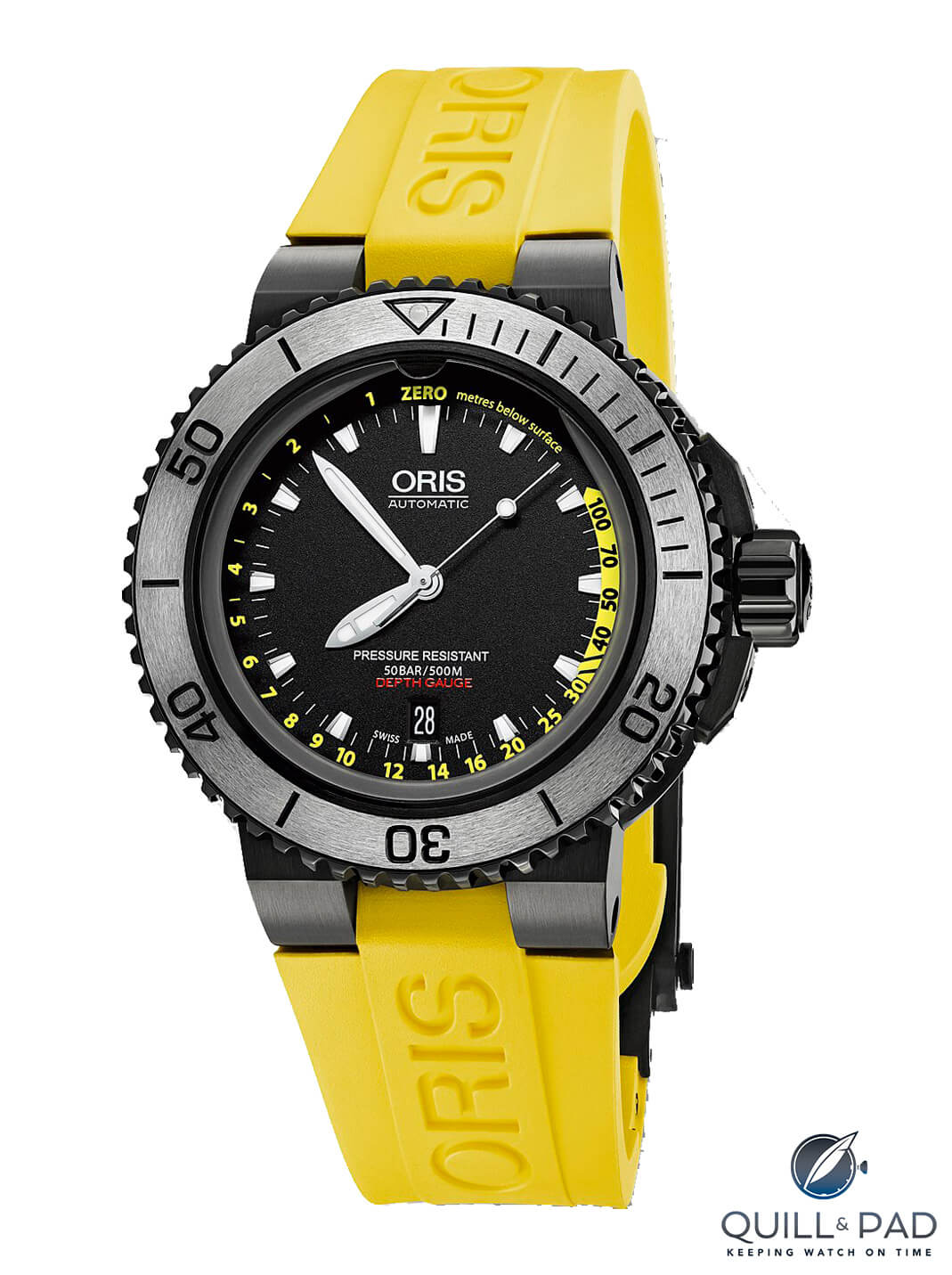
Oris Aquis Depth Gauge in yellow
The Oris Aquis Depth Gauge is probably the bestselling mechanical diving watch/depth gauge combo on the market. The one pictured here is a fine example – even the coloring makes it a real diving tool.
Bourdon tube depth gauge
The Bourdon depth gauge also uses a tube (the Bourdon tube) that fills with water as the diver descends. But in this case, the curved tube straightens out thanks to the incoming water. The straightening process translates to a scale in such a way that the greater depths are further spread out.
So this is a much better device to register a more precise reading at greater depth, but it is not as ideal as the Boyle-Mariotte type in the shallows.
The biggest disadvantage of both of these types of depth gauge is the fact that both the entrance to the tube and the tube itself can be blocked by floating algae, debris, silt, sand, and rust while wreck or cave diving.
And even in perfect water conditions, drying salt crystals could become a problem – not for the average sport diver, but more for the manufacturer, who has to keep the watch functioning.
IWC made the perfect example – and as far as I know the only one – of a mechanical watch with built-in Bourdon tube depth gauge. This was a fine piece of watchmaking and one I’m missing in my own collection.

IWC Aquatimer Depth One
I especially like the almost parallel displays of depth and time. This would be ideal for diving the 90th rule (please see The Diving Bezel: The Most Versatile Watch ‘Complication,’ Even If You’re Not A Diver): 30 minutes in 30 meters – no decompression.
Perfect for sport diving! The pros, however, would miss their abyssal dives as the depth gauge readings stop at 44 meters.
Which was probably the reason why what was in my opinion the finest (and only) example of Bourdon tube-type diving watch was discontinued so quickly. There has never been another diving watch with Bourdon tube depth gauge since.
—————————————————————————————–
—————————————————————————————–
Membrane (aneroid) depth gauge
The membrane-type depth gauge is perhaps the smartest solution for displaying diving depth on a watch dial. It is also widely used on land to measure barometric pressure, where it is commonly known as an aneroid can.
In 1968 Favre-Leuba was the first to use this method to include a depth gauge in its diving watches, and I was thrilled to get a look at this brand’s fine retro-styled timepiece introduced on its 50th anniversary at the 2018 edition of Baselworld.
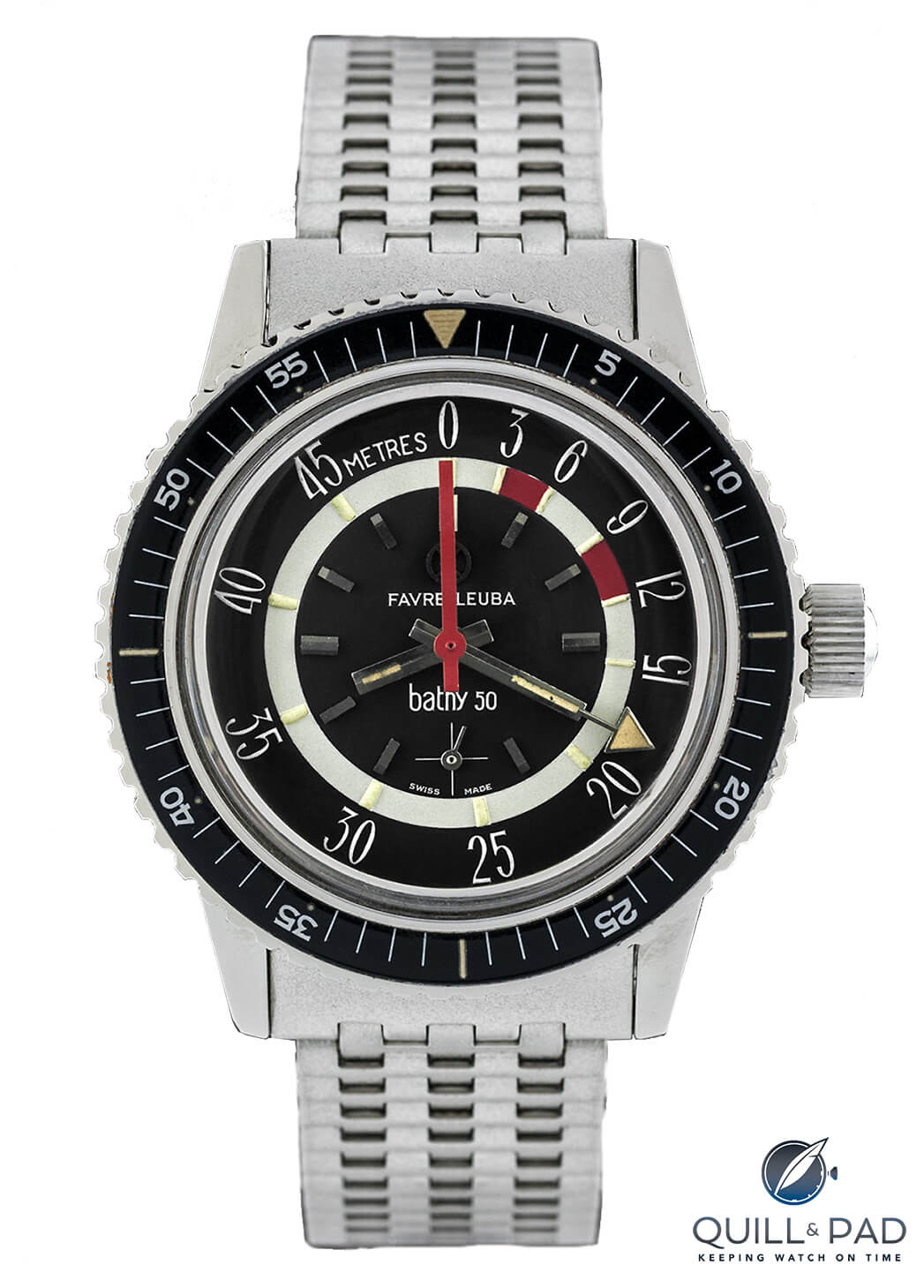
Favre-Leuba Bathy 50
The first diving watch with a depth gauge was to my knowledge the Favre-Leuba Bathy 50 – as its name reveals, it could measure diving depth to 50 meters (160 feet in the U.S. version).
I have never had the chance to dive with one of the new (and hopefully still current) Favre-Leuba Bathy models. I had the opportunity with a vintage model, and due to its large dial it was a great experience, but the watch came to me while I was stationed in the U.S. so I had to fight the measuring system in feet (rather than meters), which for diving is a real pity.

Favre-Leuba Bathy 160
After the success of the first Bathy, Favre-Leuba put the same system in its even bigger square-shaped successor – a state-of-the-art design in the 1970s.
This limited edition U.S. model features the same depth gauge with markings in feet and U.S. Divers branding, at the time the leading dive equipment manufacturer in the United States.
U.S. Divers was the American offshoot of La Spirotechnique, who sold the Cousteau/Gagnan-invented AquaLung. Today the company is named for its most famous valve, AquaLung.
Check the spacing between 40, 80, 120, and 160 feet on the display of the Favre-Leuba – it’s the same. So the depth is easy to grasp. But according to the scale you couldn’t go deeper than about 50 meters/160 feet with the Bathy 50/160, and that was not enough for that time.
Well, maybe for the Americans, who invented PADI – and PADI invented easy diving – but that’s not my world. I like complication.
Which is why I was so impressed by 2018’s commemorative model that goes to 120 meters! I sincerely hope that Favre-Leuba will a get a chance to introduce these watches more successfully to the dive community as we might be more interested in such a tool than the average buyer of luxury watches.

Favre-Leuba Bathy 120 Memodepth
Just as quickly as diver’s watch aficionados reacted to the new Bathy 120 Memodepth, it seems to have disappeared. Favre-Leuba had done everything right for divers but perhaps wasn’t able to attract enough watch lovers?
Hard to say, but I tremendously like this watch and would like to get my hands on one.
—————————————————————————————–
—————————————————————————————–
Aside from Favre-Leuba, there have been three other companies working with membrane depth gauges. One was IWC, who followed up its Aquatimer Deep One with two membrane depth gauge models: Deep Two (2009-2014) and Deep Three (2014-2018).
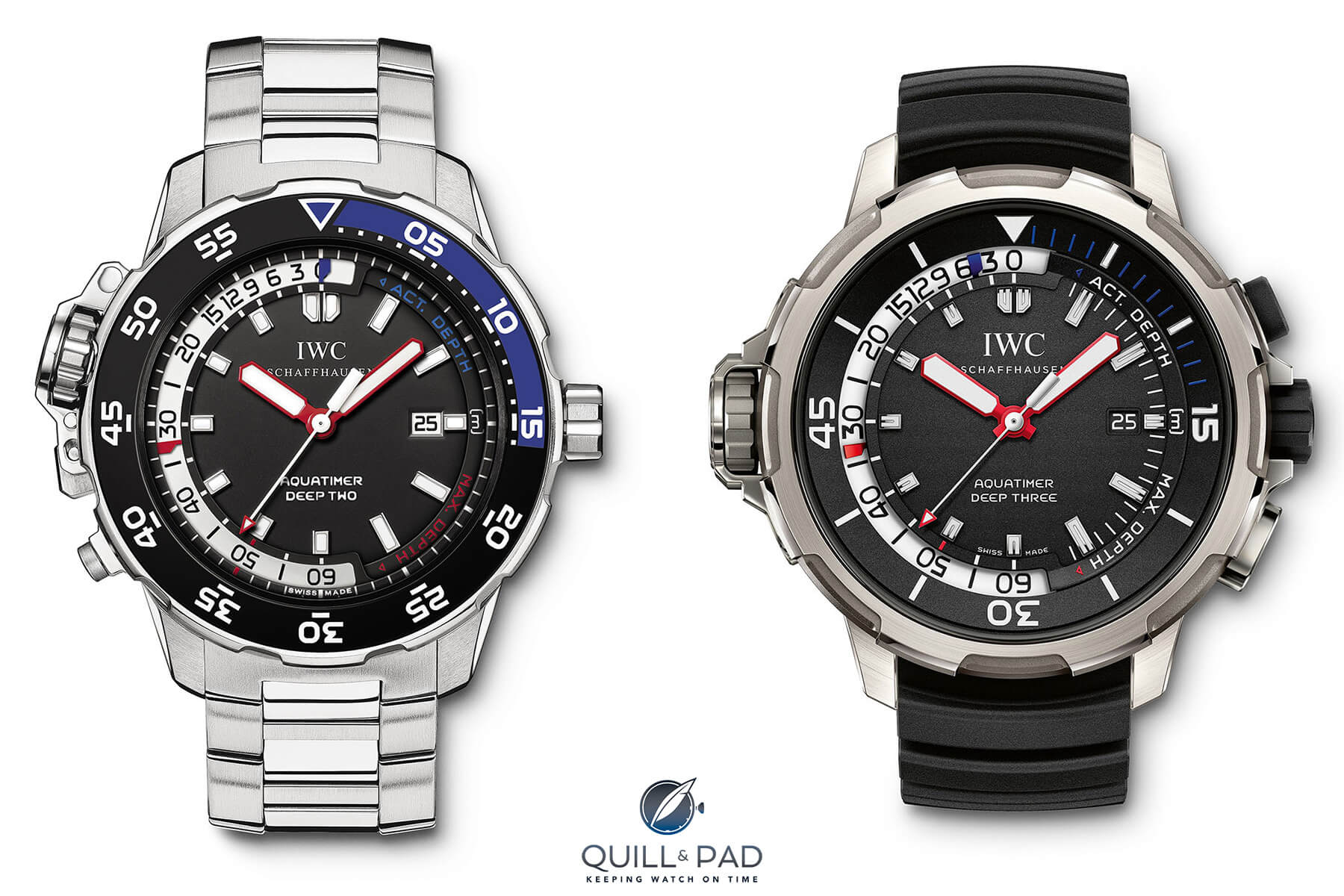
IWC Aquatimer Deep Two (left) and Deep Three
The IWC Deep Two uses a membrane depth gauge, which probably worked well enough since the brand also came out with a Deep Three with one as well. Unfortunately, IWC stopped production of diving watches with depth gauges in 2018.
Two years before the Deep Two came out with its interesting version of the membrane depth gauge, Jaeger-LeCoultre introduced its take on an aneroid box on a watch that transposed water pressure without letting any water enter the watch.

Jaeger-LeCoultre Master Compressor Diving Pro Geographic
The JLC Master Compressor Diving Pro Geographic perhaps holds the world record for the diving watch with the longest name, however it featured a new kind of membrane pressure gauge. Instead of a flat chamber with a big membrane (that would require a big case), the Jaeger-LeCoultre Master Compressor Diving Pro Geographic used a vertical chamber with a small pressure lid and a spring inside – so it’s not quite an aneroid can.
This watch also incorporated a second time zone (the subdial at 9 o’clock) and a power reserve indication (5 o’clock) in addition to the date. So many complications in one watch certainly account for the long name.
The Diving Pro Geographic also came in a limited gold edition for the Navy Seals: fighting men meet luxury watch. This timepiece certainly loves contradictions!
There were also some problems with membrane depth gauges even if they didn’t clog. The problem with the models from IWC and Jaeger-LeCoultre was the quite small pressure plate, the device that is pressed inside the watch by the water, moving a spring that activates a system of gears to display the depth.
The problem: the smaller this plate was, the more difficult it was to get an exact “data transfer.” Thus, the reliability of the indicated depth is put in question – a question that could become life threatening when diving to a depth of 80 meters. As fantastic this mechanism might be in theory, it was questionable as reliable equipment for the serious diver.
As a collector with limited money, I would have gone for the IWC Deep Two with its great history and great mechanics. Nobody is doing decompression dives with this watch anyway.
That leaves two brands: Favre-Leuba with its “new” 2018 Memodepth and Blancpain, who introduced the X Fathoms exactly ten years ago – which still has one problem in regard to membrane depth gauges: the membrane itself.
An aneroid can depth gauge in the old sense features a metal membrane that compresses when descending and depresses when ascending. Over time, this membrane will weaken and wear out, at which point you either recalibrate the depth gauge before each dive (to keep it very precise) or suffer with misreading after a while.
And, to get a bigger surface for better pressure transmission you need to have a bigger watch case. Just compare the relatively small IWC and Jaeger-LeCoultre watches with conventional depth gauges. These instruments are really big. Thus, both the Favre-Leuba and the Blancpain X Fathoms are big!
The membrane still leaves one problem open. As I mentioned earlier, the depth reading in the first 12 meters should be as precise as possible to allow for decompression stops that normally take place at 12, 9, 6, and 3 meters.
For depth gauges it’s either great decompression readings or more precise depth indication down deeper, so deep-sea divers often use two instruments. This is no problem if you buy two depth gauges that cost about €50 apiece, but I have never seen a diver with both a Favre-Leube and an Oris!
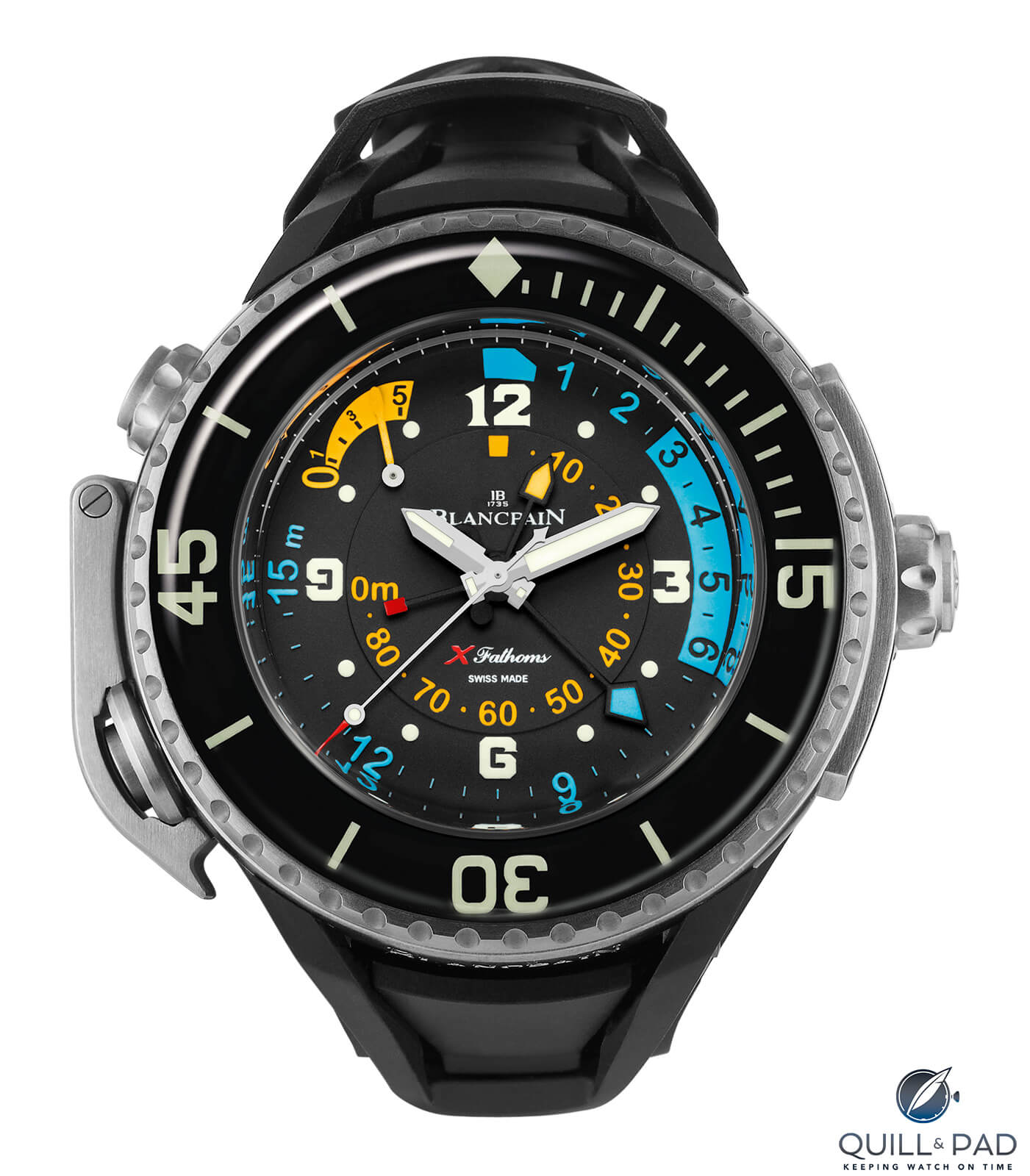
Blancpain X Fathoms
The Blancpain X Fathoms is the mother of all diving watches with a depth gauge inside highlighting what a leading Swiss watch manufacturer is capable of – especially when divers are part of the company’s leadership.
Aside from solving the problem of the metal membrane in an aneroid can, the X Fathoms also solved the problem of getting two different readings for its depth measurements: one for diving deep (91.45 meters = 50 fathoms) and the other for a detailed scale of decompression depth readings – plus an extra decompression timer on top – to make full use of the big dial in the 51 mm watch case.
In a word big is beautiful – if it weren’t for its big price tag of €30,000!
—————————————————————————————–
—————————————————————————————–
So the same guy who introduced the renewed version of the first diving watch with a diver’s bezel (see The Diving Bezel: The Most Versatile Watch ‘Complication,’ Even If You’re Not A Diver) also introduced a watch with a depth gauge that seems to have solved all problems mentioned so far.
And because this same guy and I have done quite a few interesting and advanced dives together, I can attest that this “watchmaker” knows more about diving than any other I know. I’m talking about Marc A. Hayek and his famous – and, alas, unaffordable for me – Blancpain X Fathoms.
Okay, Marc might argue that last statement as price hasn’t deterred the large number of serious divers I’ve seen using the X Fathoms – but that is another story (coming soon).
Before I go into more detail about diving Blancpain’s X Fathoms and Favre-Leuba’s Bathy 120, I’ll explain why these two watches are different: as already mentioned, they are quite big as they both feature metal membranes underneath their bottom plates.
And, yes, water enters the outer case and presses on a big plate, which provides exact depth readings.
But on both watches we see big openings that can’t be clogged easily and no tubes, just one big “pressure room.” And to solve the weakening of the metal, Blancpain introduced an amorphous metal membrane that features elastic properties and a resistance to permanent deformation, making it ideal for use as the depth gauge membrane.
Favre-Leuba also used a special alloy to incorporate long-term stability into the membrane and thus the depth gauge. To construct a mere depth gauge with one of these membranes would raise the price more than tenfold, which only makes sense in an expensive luxury watch – and that is what you get with the Favre-Leuba and the Blancpain.
But on top of that, Blancpain added two depth gauges to one case, and its dial features two depth displays, one for the deep and one for decompression in the shallows. There is no other depth gauge watch I know of offering that.
Now for the fun part. As mentioned, I haven’t yet managed to dive with the Favre-Leuba and am impatient to borrow one and for international travel to recommence so I can reach my favorite deep Austrian lakes.
I have done many dives with the X Fathoms and have pictures to prove it (coming soon to this theater).
Three inevitable questions:
1. Why not the Panerai Luminor 1950 Submersible Depth Gauge?
Easy answer: this very impressive watch (just) features an electronic depth gauge.
2. Why talk and read about diving watches with depth gauges if there are dive computers that can do everything much better?
Even easier answer: why talk and write about mechanical watches after the advent of electronic and quartz watches? Because it is fun – and I would argue that no electronic device is as reliable as its mechanical counterpart, especially while immersed in saltwater and put under severe pressure.
3. Why nothing about the (in)famous Vulcain Nautical?
Answer: because the Nautical has no depth gauge at all. It’s the only mechanical decompression watch – and that’s yet another story.
* This article was first published 22 May 2021 at A Comprehensive Look At Mechanical Depth Gauge Watches
You may also enjoy:
The Diving Bezel: The Most Versatile Watch ‘Complication,’ Even If You’re Not A Diver
Why a Dive Watch should Never Be Haute Horlogerie
Blancpain Fifty Fathoms: Story Of The World’s First Diving Watch (Video)
Glashütte Original SeaQ: An Intriguing Re-Interpreted 1969 Diver’s Watch From Germany

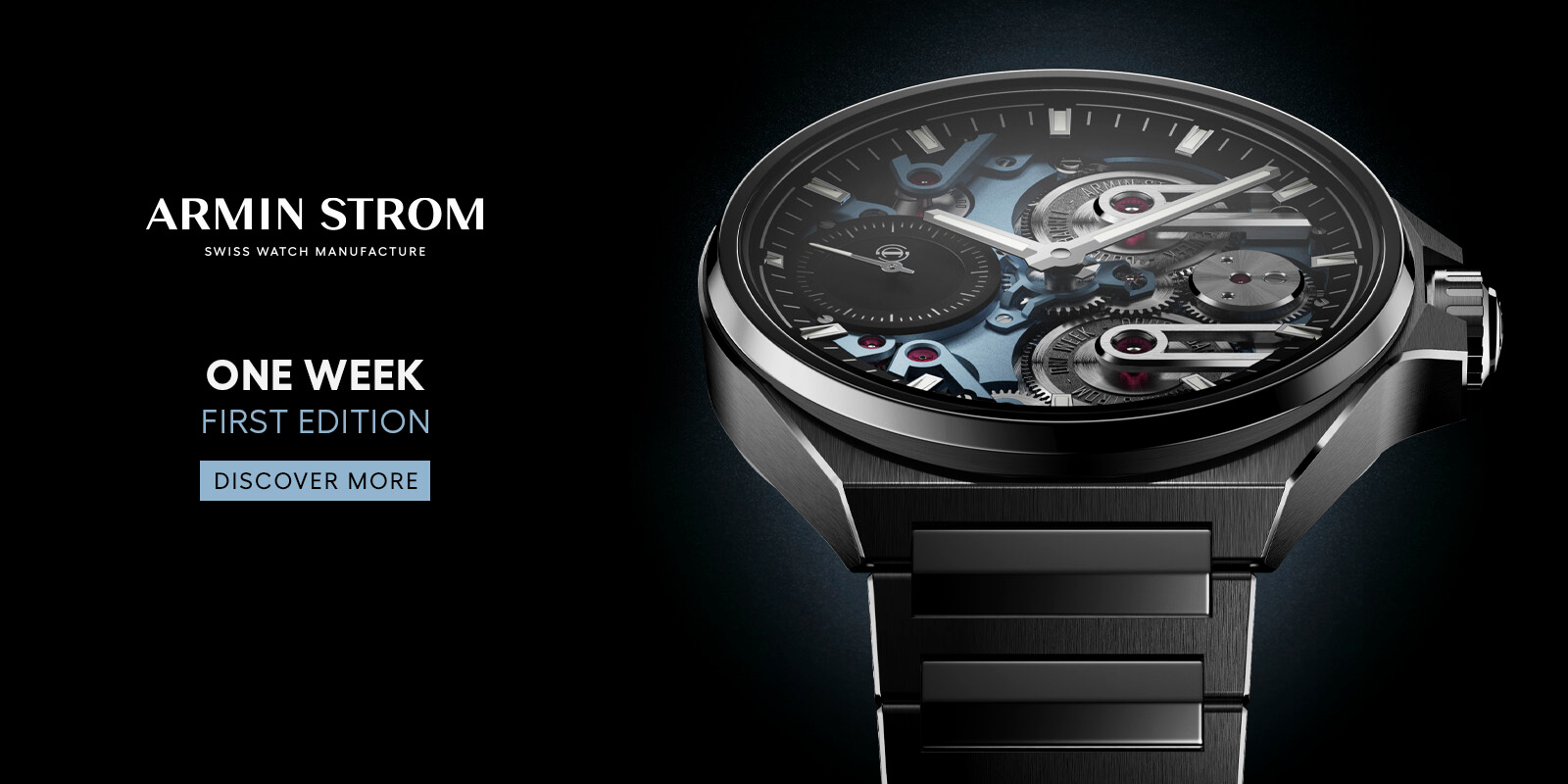


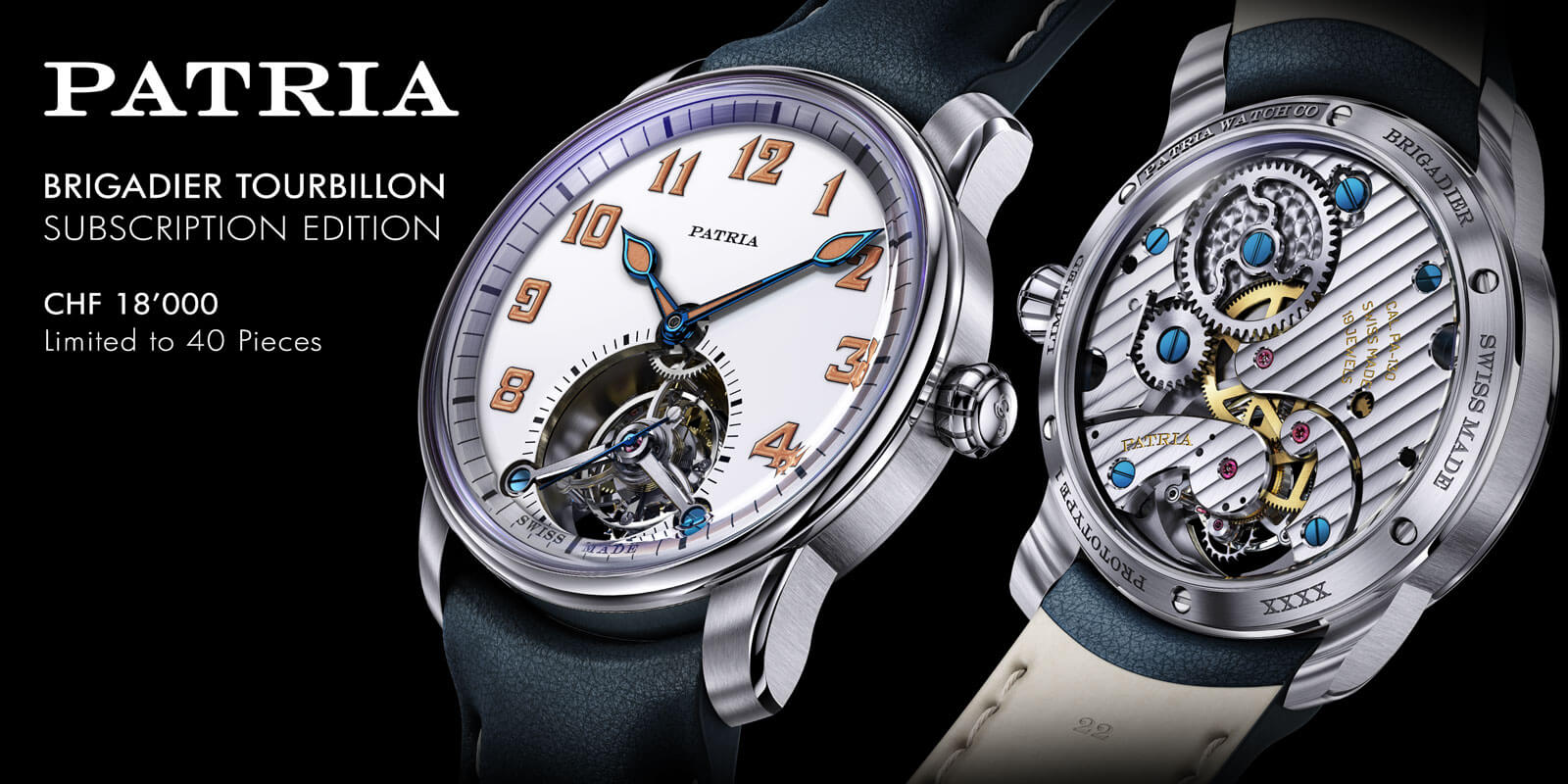


Leave a Reply
Want to join the discussion?Feel free to contribute!